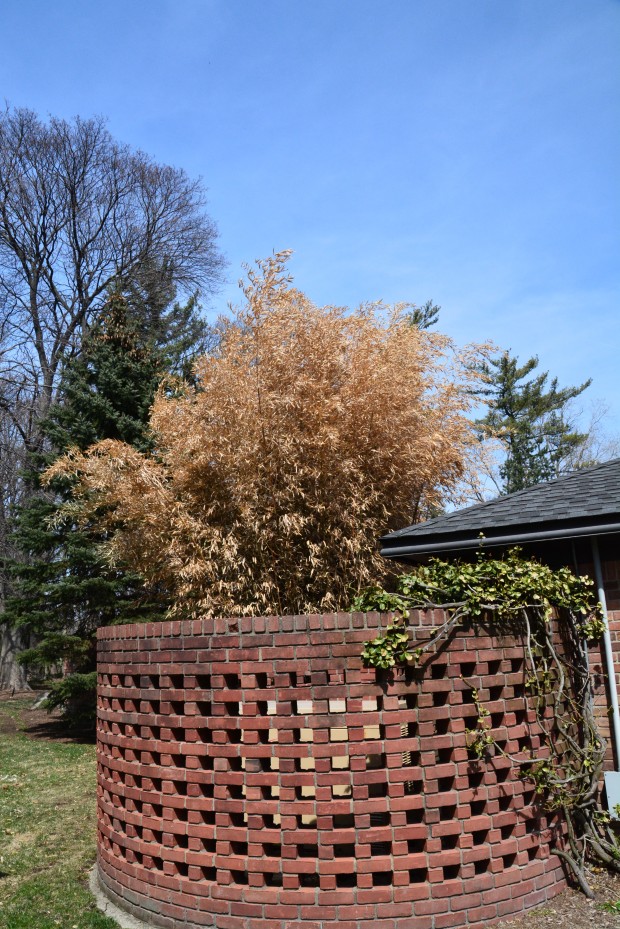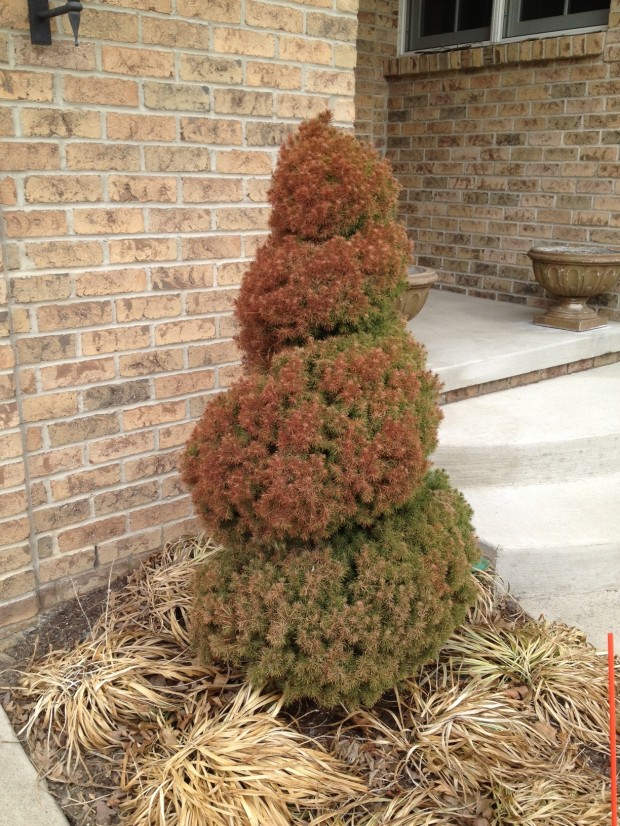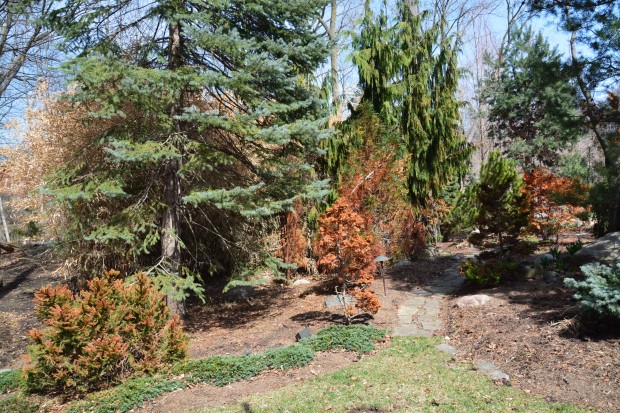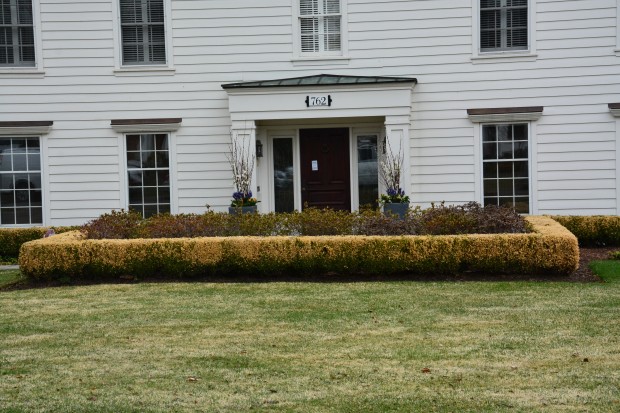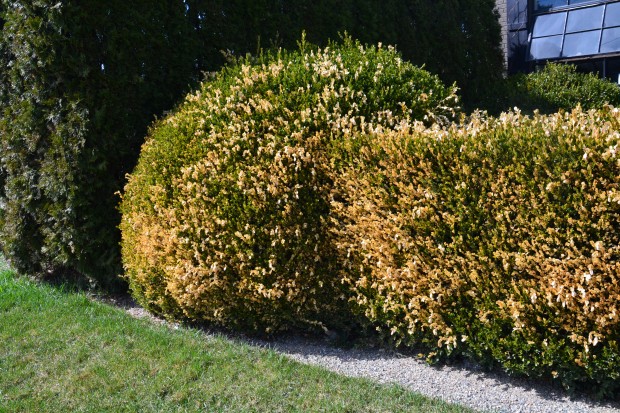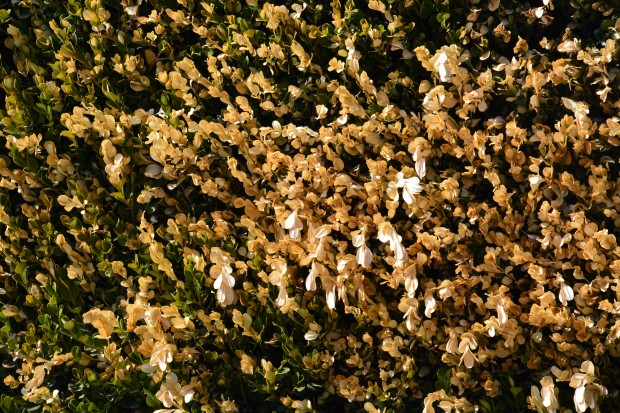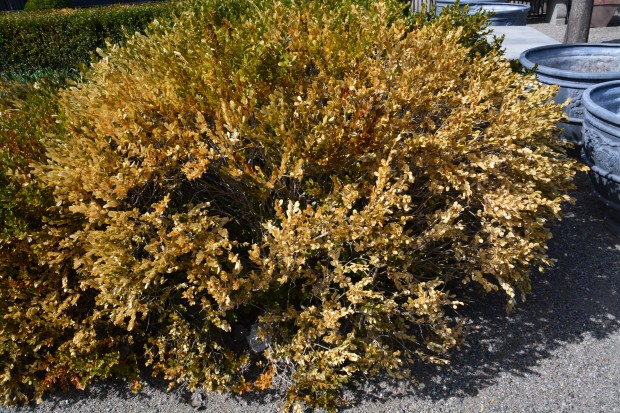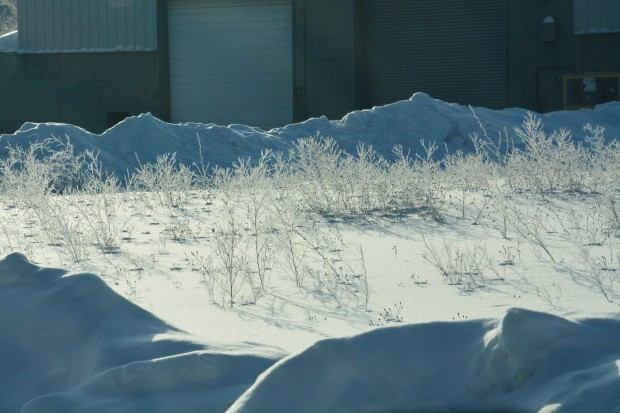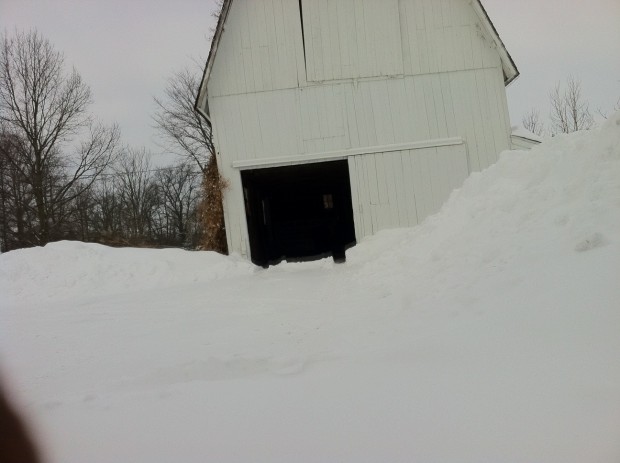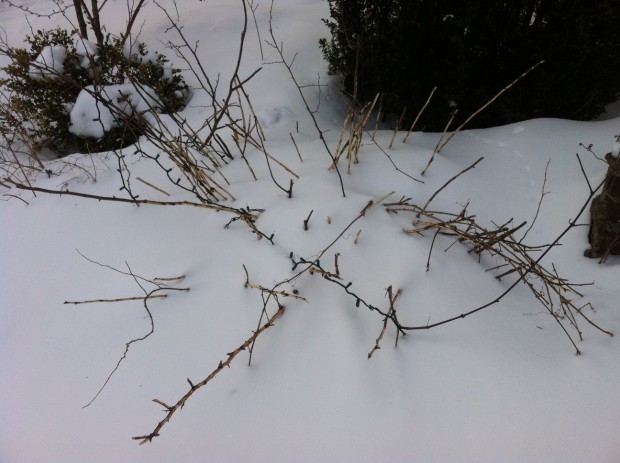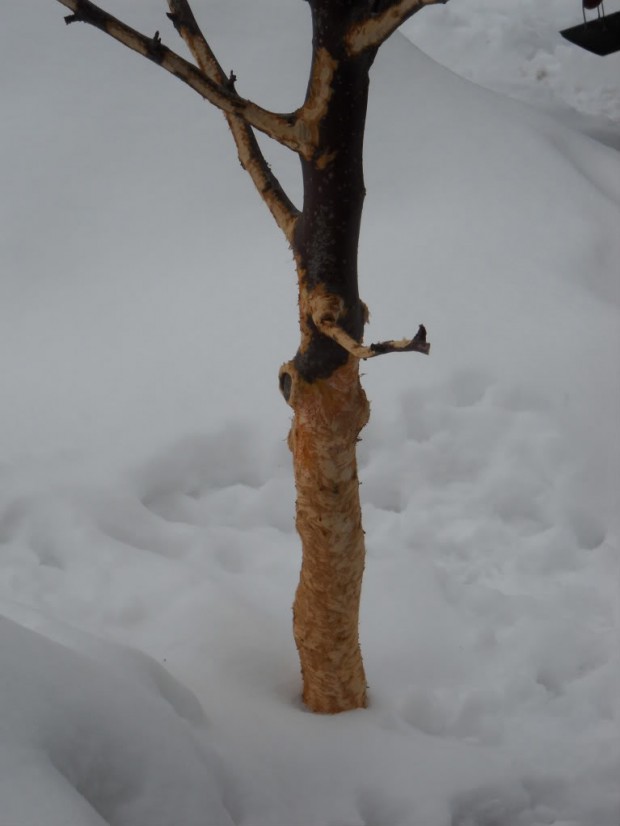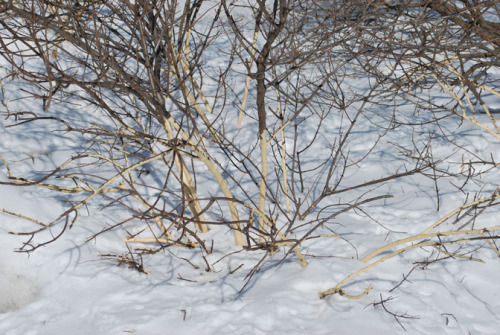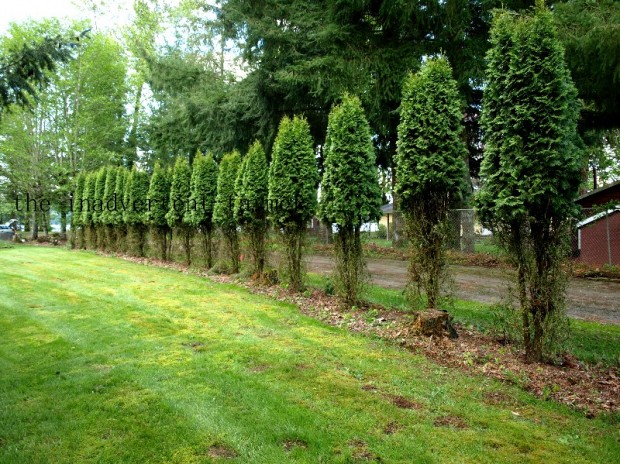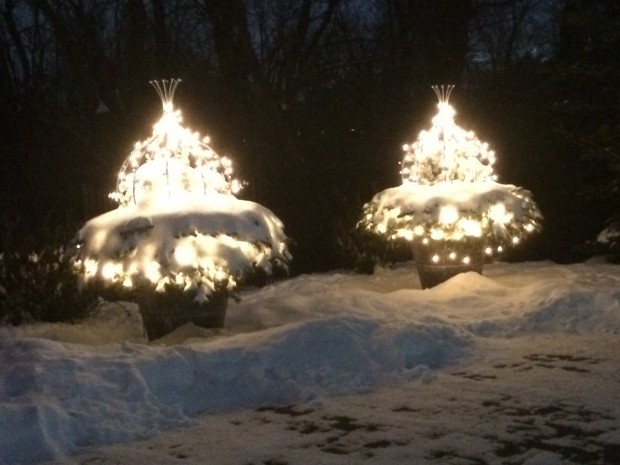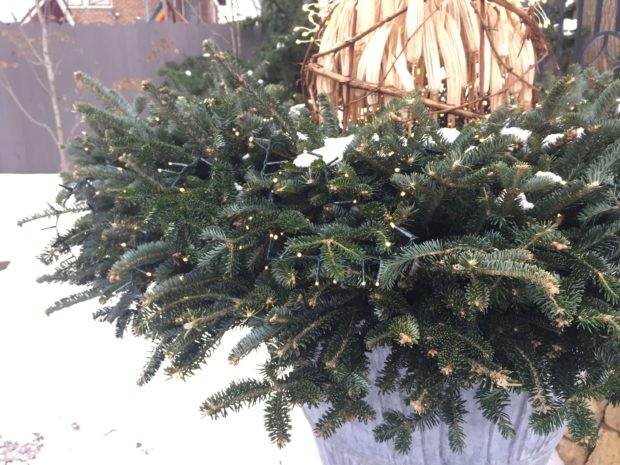 Like a good bit of the rest of the US, we were invaded by a particularly noxious and extreme cold usually confined to the northern polar regions. Fierce winds usually keep that cold where it belongs, but on occasion, that cold travels our way. In early December it became apparent that we had bitterly cold weather coming up. The first order of business was to clean out all of the fall plantings in those pots that were due to have winter arrangements, and take the soil level down four inches from the top. The floral foam form would sit on top of that lowered frozen soil. The form would be anchored into the soil with bamboo stakes, or steel rebar. Pounding a stake down through frozen soil is a good bit easier than chiselling out frozen soil. Three weeks worth of installations were accompanied by this relentless cold. Never have I been happier that we do most of our fabrication for the winter pots in the shop stockroom.
Like a good bit of the rest of the US, we were invaded by a particularly noxious and extreme cold usually confined to the northern polar regions. Fierce winds usually keep that cold where it belongs, but on occasion, that cold travels our way. In early December it became apparent that we had bitterly cold weather coming up. The first order of business was to clean out all of the fall plantings in those pots that were due to have winter arrangements, and take the soil level down four inches from the top. The floral foam form would sit on top of that lowered frozen soil. The form would be anchored into the soil with bamboo stakes, or steel rebar. Pounding a stake down through frozen soil is a good bit easier than chiselling out frozen soil. Three weeks worth of installations were accompanied by this relentless cold. Never have I been happier that we do most of our fabrication for the winter pots in the shop stockroom.
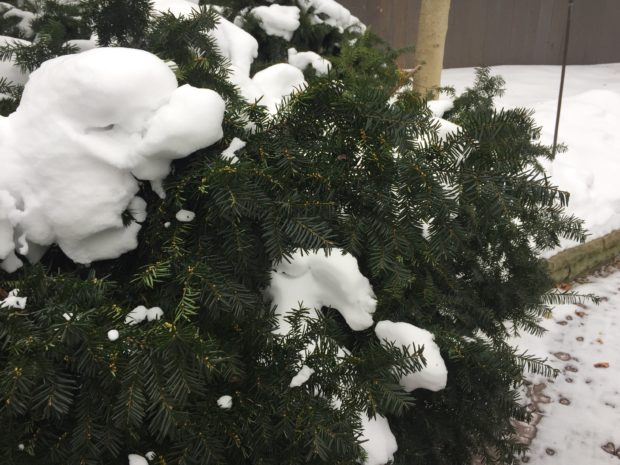 The evergreens in my garden have no where to go, and no other option but to endure. A gardener can provide their evergreens with regular water in the fall. An evergreen with juicy stems and needles is an evergreen dressed properly for the weather. Once the ground freezes, the plants will no longer be able to transmit moisture from the roots to the needles. An evergreen that goes into the dormant season dry is poorly positioned to deal with desiccating winter winds and sun, and the inevitable loss of moisture from transpiration. The water that evaporates from the needled foliage of this yew cannot be replaced until the ground thaws.
The evergreens in my garden have no where to go, and no other option but to endure. A gardener can provide their evergreens with regular water in the fall. An evergreen with juicy stems and needles is an evergreen dressed properly for the weather. Once the ground freezes, the plants will no longer be able to transmit moisture from the roots to the needles. An evergreen that goes into the dormant season dry is poorly positioned to deal with desiccating winter winds and sun, and the inevitable loss of moisture from transpiration. The water that evaporates from the needled foliage of this yew cannot be replaced until the ground thaws.
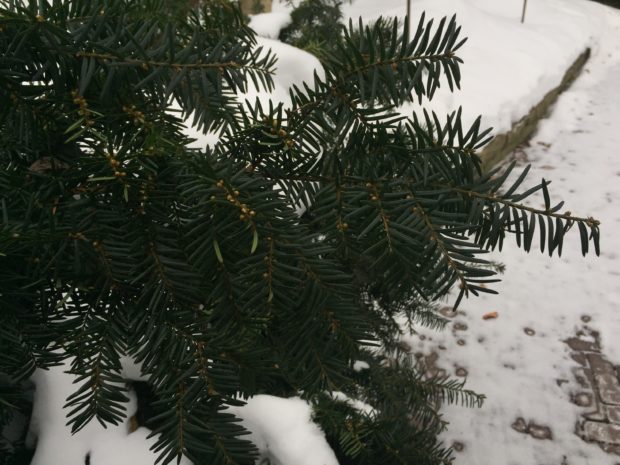 That many evergreens have needled foliage as opposed to leaves is a survival mechanism, courtesy of nature. Each needle has a relatively small surface area from which moisture can evaporate. Leaves are poor conservators of water, as they present so much surface area to sun and wind. It is no wonder that deciduous trees and shrubs drop their leaves in the fall. Carrying a full set of green leaves through the winter would most likely be deadly. At the extreme other end of the spectrum, cactus have evolved to have spines in place of those leaves that are so ill equipped to conserve moisture. Those spines do collect water from rare rains, which then drips down to the roots. Water in some degree is essential to the life of plants. I may let plenty of things go in the garden, but I do water. Plants that do not get the moisture they need are stressed and vulnerable plants.
That many evergreens have needled foliage as opposed to leaves is a survival mechanism, courtesy of nature. Each needle has a relatively small surface area from which moisture can evaporate. Leaves are poor conservators of water, as they present so much surface area to sun and wind. It is no wonder that deciduous trees and shrubs drop their leaves in the fall. Carrying a full set of green leaves through the winter would most likely be deadly. At the extreme other end of the spectrum, cactus have evolved to have spines in place of those leaves that are so ill equipped to conserve moisture. Those spines do collect water from rare rains, which then drips down to the roots. Water in some degree is essential to the life of plants. I may let plenty of things go in the garden, but I do water. Plants that do not get the moisture they need are stressed and vulnerable plants.
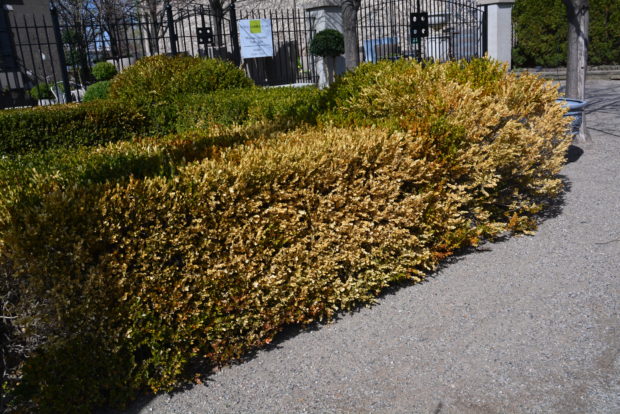 Of course our long run of cold has me worrying about the boxwood. They are broad leaved evergreens. Those leaves readily desiccate in extreme wind and cold. They are prime candidates for winter burn. A drench of anti desiccant such as Vapor Gard on both the tops and the bottoms of the leaves coats the surface with a waxy natural compound of pine resin that reduces the evaporation rate. It is amazing what a difference an anti desiccant can make. Any evergreen planting I do after the middle of August gets Vapor Gard ahead of the first winter. It is very inexpensive insurance against disaster. The above picture was taken in April of 2014. These 20 year old shrubs were killed outright from the extreme cold we experienced in the winter of 2013-2014. Double digit below zero temperatures for days on end proved too much for them. The 100 inches of snow we had went beyond insulating them to overloading them with branch cracking weight.
Of course our long run of cold has me worrying about the boxwood. They are broad leaved evergreens. Those leaves readily desiccate in extreme wind and cold. They are prime candidates for winter burn. A drench of anti desiccant such as Vapor Gard on both the tops and the bottoms of the leaves coats the surface with a waxy natural compound of pine resin that reduces the evaporation rate. It is amazing what a difference an anti desiccant can make. Any evergreen planting I do after the middle of August gets Vapor Gard ahead of the first winter. It is very inexpensive insurance against disaster. The above picture was taken in April of 2014. These 20 year old shrubs were killed outright from the extreme cold we experienced in the winter of 2013-2014. Double digit below zero temperatures for days on end proved too much for them. The 100 inches of snow we had went beyond insulating them to overloading them with branch cracking weight.
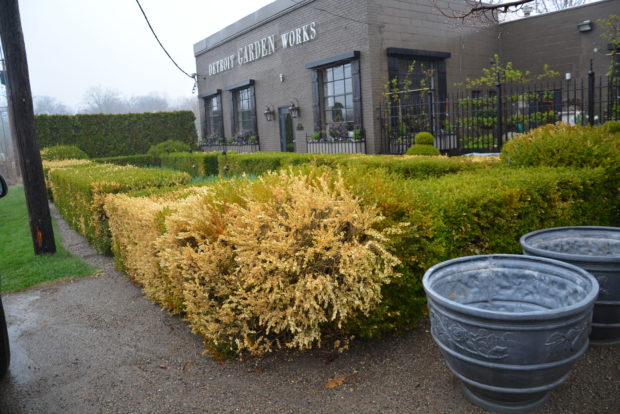 A boxwood disaster is rarely apparent before April. That makes it easy to fret over them all winter.
A boxwood disaster is rarely apparent before April. That makes it easy to fret over them all winter.
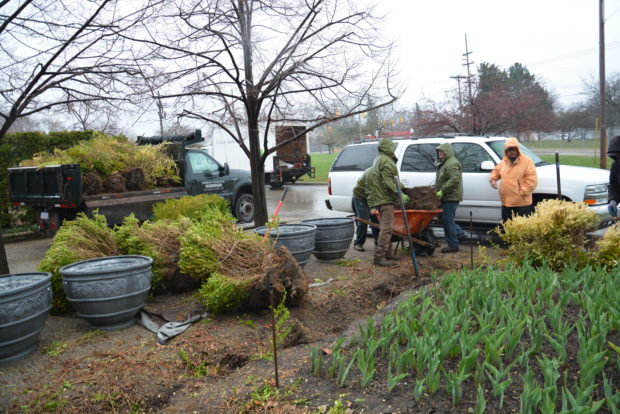 This day was a heartbreaking day. That day in April made it obvious that the west end section of this old hedge had perished. It succumbed to a once in a lifetime extended cold well below its hardiness limit. The entire summer of 2014 I drove by so many hedges of dead boxwood still in the ground. I could not have looked at dead plants day after day, and month after month, but disbelief, grief and denial can be very powerful.
This day was a heartbreaking day. That day in April made it obvious that the west end section of this old hedge had perished. It succumbed to a once in a lifetime extended cold well below its hardiness limit. The entire summer of 2014 I drove by so many hedges of dead boxwood still in the ground. I could not have looked at dead plants day after day, and month after month, but disbelief, grief and denial can be very powerful.
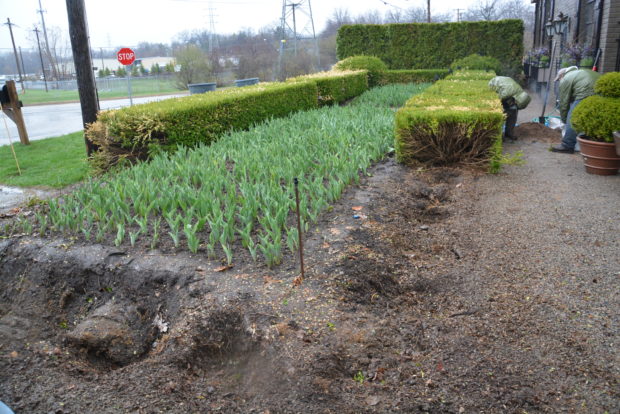 Do I think the extreme cold spell we have just had will kill my boxwood? Our coldest temperature was 6 below zero. This is not cold enough to kill a zone 5 shrub. It was cold enough to make me dress from top to bottom for bone chilling cold. I limited the time the corgis spent outdoors. One morning at 4 degrees below zero they came in limping after 3 minutes outdoors. Cold feet. But I do not believe it has been cold enough to seriously damage the boxwood.
Do I think the extreme cold spell we have just had will kill my boxwood? Our coldest temperature was 6 below zero. This is not cold enough to kill a zone 5 shrub. It was cold enough to make me dress from top to bottom for bone chilling cold. I limited the time the corgis spent outdoors. One morning at 4 degrees below zero they came in limping after 3 minutes outdoors. Cold feet. But I do not believe it has been cold enough to seriously damage the boxwood.
 Once we finished removing the section of dead plants, we placed big Branch pots in front of the bare ends of the boxwood. It would be every bit of several years before the dead spots and sections would recover from this winter. Note that the tulips coming on sustained no damage from the extreme cold. They were completely dormant, and below ground. Sub shrubs such as lavender, that have live branches above ground in the winter, can be very difficult to winter over.
Once we finished removing the section of dead plants, we placed big Branch pots in front of the bare ends of the boxwood. It would be every bit of several years before the dead spots and sections would recover from this winter. Note that the tulips coming on sustained no damage from the extreme cold. They were completely dormant, and below ground. Sub shrubs such as lavender, that have live branches above ground in the winter, can be very difficult to winter over.
 We did finally get the window boxes and 2 pots in front of the shop done up for winter. They feature cut boxwood twigs stuffed into dry floral foam. After just a few days outdoors, they began to show the signs of leaf shrinkage from evaporation.
We did finally get the window boxes and 2 pots in front of the shop done up for winter. They feature cut boxwood twigs stuffed into dry floral foam. After just a few days outdoors, they began to show the signs of leaf shrinkage from evaporation.
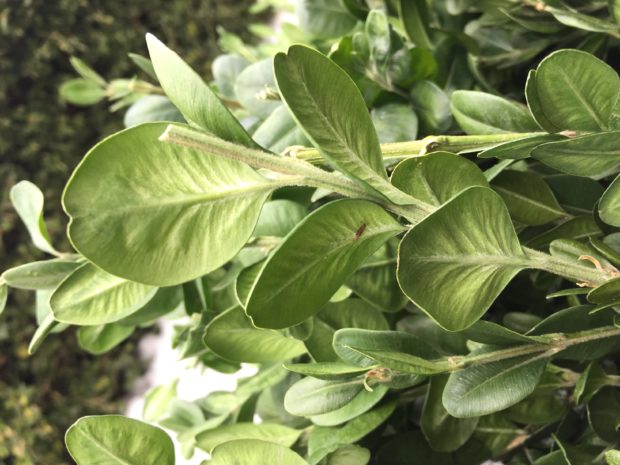 Even the backs of the leaves show signs of stress. As long as these cut stems were packed in wax coated boxes, and not exposed to sun or wind, the leaves were glossy and plump. Once exposed to the weather, they reacted as expected. Fortunately boxwood leaves stay green even as they dry.
Even the backs of the leaves show signs of stress. As long as these cut stems were packed in wax coated boxes, and not exposed to sun or wind, the leaves were glossy and plump. Once exposed to the weather, they reacted as expected. Fortunately boxwood leaves stay green even as they dry.
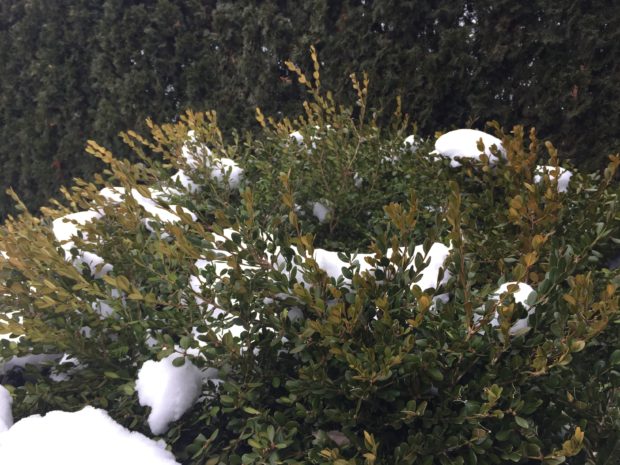 I am sure we will have burned and dead tips on these plants come spring, but I expect them to recover. 32 degrees this morning-what a relief.
I am sure we will have burned and dead tips on these plants come spring, but I expect them to recover. 32 degrees this morning-what a relief.


